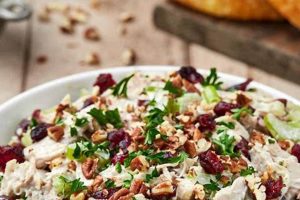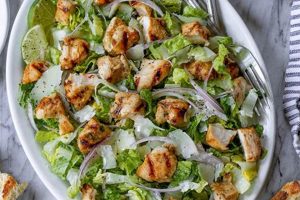A combination of cooked chicken, typically shredded or diced, mayonnaise, and sweet, crisp grapes, along with the added texture and flavor of nuts, creates a popular and versatile dish. Variations often include celery, onion, and seasonings like salt, pepper, and paprika. A simple preparation involves combining the ingredients in a bowl and chilling for optimal flavor blending.
This dish offers a balance of protein, healthy fats, and natural sweetness, making it a nutritious and satisfying meal or snack. Its adaptable nature allows for modifications based on dietary needs and preferences. From picnics and potlucks to quick lunches and light dinners, its versatility has contributed to its enduring popularity. Historically, similar combinations of poultry, fruit, and nuts can be traced back to various culinary traditions, solidifying its place as a classic dish.
Further exploration will cover variations on this dish, including ingredient substitutions, different types of grapes and nuts, and suggestions for serving and presentation. Additional topics will include nutritional information and tips for making this dish ahead of time.
Tips for a Superior Chicken Salad with Grapes and Nuts
Preparation methods and ingredient selection significantly impact the final quality of this classic dish. Careful attention to these details ensures a flavorful and enjoyable experience.
Tip 1: Chicken Selection: Rotisserie chicken offers a convenient and flavorful shortcut. Alternatively, poaching or baking chicken breasts results in a leaner, milder flavor. Avoid using pre-cooked, packaged chicken, as it can often be dry and lack flavor.
Tip 2: Grape Variety: Seedless red or green grapes offer a pleasant sweetness and satisfying pop. Consider using a mix of both for a balanced flavor profile. Avoid overly ripe grapes, which can become mushy.
Tip 3: Nut Choices: Toasted pecans or walnuts add a rich, buttery flavor and satisfying crunch. Almonds or cashews offer a milder, sweeter alternative. Ensure nuts are fresh and not rancid.
Tip 4: Mayonnaise Matters: High-quality mayonnaise is crucial for a creamy, flavorful salad. Consider using a combination of mayonnaise and plain Greek yogurt for a lighter, tangier flavor.
Tip 5: Enhancing Flavor: Fresh herbs, such as dill, tarragon, or chives, add a bright, fresh element. A dash of Dijon mustard or a pinch of celery seed can also enhance the overall flavor profile.
Tip 6: Chilling Time: Allowing the salad to chill for at least 30 minutes allows the flavors to meld and develop fully. This step significantly improves the overall taste and texture.
Tip 7: Serving Suggestions: Serve the salad on croissants, crackers, lettuce cups, or as a sandwich filling. Garnish with extra grapes, nuts, and fresh herbs for an appealing presentation.
By following these tips, one can elevate a simple chicken salad into a truly exceptional dish. Attention to detail, from ingredient selection to chilling time, results in a superior culinary experience.
This comprehensive guide concludes with variations and adaptations of this classic recipe to suit a variety of tastes and dietary preferences.
1. Chicken (cooked, diced)
Cooked, diced chicken forms the foundational protein component of chicken salad with grapes and nuts. Its preparation and characteristics significantly influence the overall texture and flavor profile of the final dish. Understanding the nuances of chicken selection and preparation is crucial for achieving a balanced and satisfying salad.
- Cooking Methods
Various cooking methods yield different results. Poaching or baking produce lean, moist chicken with a neutral flavor, allowing other ingredients to shine. Rotisserie chicken offers a convenient shortcut with enhanced flavor, while grilling imparts a smoky char. Overcooked chicken, regardless of the method, results in a dry, less desirable texture in the final salad.
- Dicing Technique
The size of the diced chicken affects both texture and the distribution of flavor. Smaller dice creates a smoother, more uniform texture, while larger pieces provide more substantial bites. Uniform dicing ensures even distribution of chicken throughout the salad, preventing pockets of mayonnaise or an uneven protein-to-other-ingredient ratio.
- Chicken Type
Chicken breast offers a lean protein source, while using dark meat from thighs or drumsticks contributes a richer flavor and increased moisture. A combination of both white and dark meat can achieve a balance between flavor and leanness. The chosen chicken type impacts the overall nutritional profile of the salad.
- Bone-in vs. Boneless
While boneless, skinless chicken breasts provide convenience, bone-in chicken often yields more flavorful results. The bones contribute additional flavor during cooking, which enhances the overall taste of the salad. If using bone-in chicken, careful removal of bones and cartilage is crucial before dicing to ensure a pleasant eating experience.
The chosen cooking method, dicing technique, and chicken type directly impact the final quality of chicken salad with grapes and nuts. Careful consideration of these factors ensures a well-balanced and flavorful dish with a pleasing texture. The interplay between the chicken and the other ingredients, including the sweetness of grapes and the crunch of nuts, ultimately determines the overall dining experience.
2. Mayonnaise (high-quality)
Mayonnaise serves as the emulsifying and flavor-binding agent in chicken salad with grapes and nuts. Its quality directly impacts the overall texture, taste, and enjoyment of the dish. High-quality mayonnaise, typically made with egg yolks, oil, vinegar or lemon juice, and seasonings, provides a rich, creamy texture and a balanced tang that complements the other ingredients. Lower-quality mayonnaise, often containing added starches and stabilizers, can result in a thinner, less flavorful, and sometimes overly sweet or tangy salad. The choice of mayonnaise influences how the flavors meld and how the salad holds its form.
Consider the difference between using a mayonnaise made with fresh egg yolks and extra virgin olive oil versus one made with processed oils and artificial flavors. The former imparts a rich, nuanced flavor that enhances the chicken and fruit, while the latter might introduce unwanted sweetness or a cloying texture. Furthermore, high-quality mayonnaise provides better emulsification, preventing the salad from becoming watery or separating over time. This characteristic is crucial for maintaining a desirable texture and preventing the salad from becoming soggy, especially when making it ahead of time.
Selecting high-quality mayonnaise represents a crucial step in crafting a superior chicken salad experience. This choice directly impacts not only the flavor and texture but also the overall satisfaction derived from the dish. The interplay between the mayonnaise, the tender chicken, the sweet grapes, and the crunchy nuts creates a harmonious balance when the foundational element the mayonnaise meets a certain standard of quality. Compromising on this component can detract from the potential of the other ingredients and ultimately diminish the culinary experience.
3. Grapes (seedless, halved)
Grapes contribute a refreshing sweetness and textural counterpoint to the savory and creamy elements in chicken salad. Seedless varieties, halved for optimal size and ease of eating, are typically preferred. The choice of grape variety and its preparation significantly influence the overall balance and enjoyment of the dish.
- Variety Selection
Green grapes, such as Thompson seedless, offer a crisp, tart sweetness, while red grapes, like Flame or Crimson, provide a sweeter, slightly softer texture. Black grapes, though less common in chicken salad, introduce a more complex, subtly wine-like flavor. The selected variety influences the overall sweetness and color profile of the salad.
- Halving the Grapes
Halving the grapes serves several purposes. It creates a more manageable size for each bite, prevents whole grapes from rolling out of the salad, and exposes more surface area, allowing the grape flavor to meld more effectively with the other ingredients. Furthermore, halved grapes distribute more evenly throughout the salad, ensuring consistent flavor in each bite.
- Freshness and Quality
Fresh, plump grapes with intact skins provide the best flavor and texture. Avoid grapes that appear wrinkled, bruised, or have a dull appearance, as these may be less flavorful or even spoiled. The quality of the grapes directly impacts the overall freshness and taste of the salad.
- Balancing Flavors
The sweetness of the grapes balances the savory notes of the chicken and the richness of the mayonnaise. This interplay of flavors is crucial for creating a well-rounded and satisfying salad. The right balance prevents the salad from being overly sweet or overly savory, contributing to a harmonious flavor profile.
The careful selection and preparation of grapes play a pivotal role in the overall composition and enjoyment of chicken salad. The interplay between the grapes’ sweetness, texture, and visual appeal enhances the dish, creating a delightful balance of flavors and textures. Consideration of grape variety, freshness, and proper halving contributes significantly to the final culinary experience.
4. Nuts (toasted, chopped)
Nuts contribute a crucial textural and flavor dimension to chicken salad with grapes and nuts. Toasted and chopped, they provide a satisfying crunch and intensified flavor that complements the other ingredients. The choice of nut, the toasting process, and the chopping method significantly influence the final character of the salad.
- Nut Selection
Different nuts offer distinct flavor profiles and textures. Walnuts provide a robust, slightly earthy flavor, while pecans offer a buttery richness. Almonds contribute a mild, subtly sweet flavor, and cashews bring a creamy texture and delicate sweetness. The selected nut variety influences the overall taste and nutritional value of the salad.
- Toasting Process
Toasting nuts enhances their inherent flavors and creates a desirable crunch. Evenly toasted nuts offer a more consistent flavor and texture throughout the salad. Over-toasting, however, can result in a bitter flavor, detracting from the overall taste. Methods include toasting in a dry pan over medium heat or in an oven at a low temperature.
- Chopping Method
Chopping the nuts into smaller, relatively uniform pieces ensures even distribution throughout the salad and provides a consistent textural experience in each bite. Larger pieces offer more pronounced bursts of flavor and crunch, while finely chopped nuts create a more subtle textural element. The chopping method influences how the nuts integrate with the other ingredients.
- Quantity and Balance
The quantity of nuts added to the salad impacts both the texture and the overall flavor profile. Too few nuts can result in a less satisfying textural experience, while too many can overpower the other ingredients. A balanced ratio of nuts to chicken, grapes, and mayonnaise ensures a harmonious blend of flavors and textures.
The selection, toasting, chopping, and proportion of nuts play a significant role in the overall balance and enjoyment of chicken salad with grapes and nuts. Careful consideration of these factors contributes to a well-rounded flavor profile and a satisfying textural complexity, elevating the dish beyond a simple combination of ingredients to a more nuanced and rewarding culinary experience.
5. Seasoning (salt, pepper)
Seasoning, primarily with salt and pepper, plays a critical role in elevating chicken salad with grapes and nuts beyond a simple combination of ingredients. Salt enhances the inherent flavors of the chicken, grapes, and nuts, while pepper adds a subtle layer of complexity and depth. The proper balance of these seasonings is crucial; insufficient seasoning results in a bland, uninspired salad, while excessive seasoning can overpower the delicate interplay of sweet and savory elements. Consider the impact of kosher salt versus table salt: kosher salt’s larger crystals offer a more nuanced salinity and prevent over-salting, whereas table salt’s finer texture requires more cautious application.
Freshly ground black pepper offers a more pronounced aroma and flavor compared to pre-ground pepper, adding a subtle heat and complexity that complements the sweetness of the grapes. White pepper, while milder in flavor, can maintain a lighter color profile in the salad. Beyond salt and pepper, other seasonings, such as onion powder, garlic powder, or a pinch of paprika, can further enhance the flavor profile. However, judicious use is essential to prevent these additional seasonings from overpowering the core flavors of the chicken, grapes, and nuts. Experimentation with different pepper varieties or the addition of a small amount of cayenne pepper can introduce subtle nuances to the overall flavor profile.
Achieving the correct balance of seasonings is paramount in creating a well-rounded and flavorful chicken salad. This balance elevates the dish, allowing the individual flavors of the components to shine while creating a harmonious overall taste. The interplay between the salt, pepper, and other potential seasonings contributes significantly to the final culinary experience, demonstrating that even seemingly simple ingredients like salt and pepper can profoundly impact a dish’s success. Careful attention to seasoning transforms a basic chicken salad into a more complex and satisfying culinary creation.
6. Optional additions (celery, onion)
Celery and onion, while optional additions to chicken salad with grapes and nuts, contribute significantly to the overall texture and flavor profile. Celery, with its crisp, watery nature, adds a refreshing crunch and a subtle vegetal note that balances the richness of the mayonnaise and the sweetness of the grapes. Finely diced celery integrates seamlessly, while larger pieces offer a more pronounced textural contrast. Onion, whether red, white, or yellow, introduces a pungent, savory layer that complements the chicken and nuts. The sharpness of raw onion can be mellowed by briefly soaking the chopped pieces in cold water before adding them to the salad. This step reduces the intensity of the raw onion flavor while retaining its textural contribution.
The quantity of celery and onion added influences the final character of the salad. A small amount enhances the existing flavors without dominating, while larger quantities create a more pronounced vegetal presence. Consider the interplay of these optional additions with the core ingredients. For example, the crispness of celery provides a textural counterpoint to the creamy mayonnaise and tender chicken, while the sharpness of onion cuts through the richness of the nuts and the sweetness of the grapes. This careful balance of flavors and textures prevents the salad from becoming overly rich or sweet, resulting in a more nuanced and satisfying culinary experience. A classic example is the Waldorf salad, a close relative of chicken salad, which relies heavily on the combination of celery, apples, and walnuts for its characteristic flavor and texture.
Understanding the role of optional additions like celery and onion allows for greater control over the final flavor and texture of chicken salad with grapes and nuts. These additions offer opportunities to personalize the dish, tailoring it to individual preferences. The judicious use of celery and onion, combined with an understanding of their impact on the overall composition, elevates the salad from a simple combination of ingredients to a more complex and customizable culinary creation. Furthermore, the incorporation of these vegetables adds nutritional value to the dish, increasing its fiber and vitamin content while enhancing its flavor profile. This attention to detail, even with optional ingredients, distinguishes a thoughtfully prepared chicken salad from a more basic rendition.
7. Serving (bread, crackers)
The method of serving significantly impacts the overall enjoyment of chicken salad with grapes and nuts. The chosen vessel, whether bread, crackers, or other alternatives, influences the textural contrast, ease of consumption, and overall sensory experience. Careful consideration of serving options elevates this dish beyond a simple salad, transforming it into a more complete and satisfying meal or snack.
- Bread Choices
Various bread types offer distinct textural and flavor pairings. Croissants, with their buttery, flaky layers, provide a rich, indulgent counterpoint to the creamy salad. A crusty baguette offers a textural contrast and a neutral flavor that allows the salad’s flavors to shine. Soft, white bread provides a classic, familiar base, while whole-wheat bread adds a subtle nutty flavor and increased nutritional value. The chosen bread should complement, not overpower, the flavors of the chicken salad.
- Crackers and Crispbreads
Crackers offer a versatile and convenient serving option. Butter crackers provide a rich, buttery complement to the salad, while saltine crackers offer a simple, crisp contrast. Multigrain crackers introduce textural complexity and subtle nutty notes. Crispbreads, such as rye or flaxseed, provide a sturdy base and contribute a distinct flavor profile. The size and shape of the crackers influence the ease of handling and portion control.
- Alternative Vessels
Beyond traditional bread and crackers, alternative vessels offer creative and flavorful serving options. Lettuce cups provide a light, refreshing alternative, ideal for those seeking a lower-carbohydrate option. Avocado halves offer a creamy, flavorful base that complements the richness of the chicken salad. Hollowed-out tomatoes or bell peppers provide a visually appealing and flavorful vessel. These alternatives can enhance the nutritional value and aesthetic appeal of the dish.
- Presentation and Garnishes
Presentation elevates the dining experience. Serving the chicken salad on a bed of lettuce adds visual appeal and a refreshing element. Garnishing with extra grapes, chopped nuts, or fresh herbs enhances the visual presentation and reinforces the flavors of the salad. Consider the overall aesthetic when choosing serving vessels and garnishes. A simple garnish of chopped chives or a sprinkle of paprika can transform a basic presentation into a more visually appealing and appetizing dish.
The chosen serving method significantly impacts the overall enjoyment of chicken salad with grapes and nuts. Whether served on bread, crackers, or alternative vessels, the interplay between the vessel and the salad influences the texture, flavor, and overall sensory experience. Careful consideration of these elements elevates the dish, demonstrating that even the seemingly simple act of serving can transform a basic chicken salad into a more refined and satisfying culinary experience. From the delicate balance of flavors to the visual appeal of the presentation, every detail contributes to the final enjoyment of this classic dish.
Frequently Asked Questions
This section addresses common inquiries regarding the preparation and enjoyment of chicken salad incorporating grapes and nuts.
Question 1: How long can this type of salad be stored safely?
Prepared chicken salad should be refrigerated promptly and consumed within three to five days. Proper storage in an airtight container helps maintain quality and prevents bacterial growth. Discard any salad that exhibits signs of spoilage, such as an off odor or discoloration.
Question 2: Can alternative ingredients be substituted for dietary restrictions?
Numerous substitutions can accommodate dietary restrictions. Plain Greek yogurt or avocado can replace mayonnaise for a lower-fat and dairy-free option. Dried cranberries or chopped apples offer alternatives to grapes for individuals with specific sensitivities. Various nuts and seeds provide options for those with nut allergies. Ingredient substitutions may alter the flavor and texture profiles.
Question 3: What methods prevent the salad from becoming watery?
Excess moisture can result from watery grapes or insufficiently drained ingredients. Ensure grapes are dry before adding them to the salad. Adequately draining canned chicken, if used, also prevents excess moisture. Using high-quality mayonnaise contributes to better emulsification and prevents separation.
Question 4: Can this salad be frozen for later consumption?
Freezing is not generally recommended. Mayonnaise-based salads often separate and become watery upon thawing, resulting in an undesirable texture. The grapes and nuts may also lose their optimal texture when frozen. It’s preferable to prepare and consume the salad fresh for the best flavor and texture.
Question 5: How can one enhance the flavor profile beyond basic seasoning?
Fresh herbs, such as dill, tarragon, or chives, add brightness and complexity. Incorporating spices like curry powder or paprika introduces depth. A dash of lemon juice or apple cider vinegar provides a tangy counterpoint. These additions should be used judiciously to prevent overpowering the core flavors.
Question 6: What are optimal serving suggestions for different occasions?
Serving options vary based on the occasion. For casual settings, crackers or crusty bread provide a simple yet satisfying accompaniment. For more formal occasions, consider serving the salad in lettuce cups, avocado halves, or on croissants. Presentation and garnishes elevate the dining experience.
Addressing these frequently asked questions offers further guidance for preparing and enjoying a superior chicken salad with grapes and nuts. Attention to detail, from ingredient selection to storage methods, ensures a successful culinary experience.
The following section will delve into various recipe variations to inspire culinary creativity and cater to individual preferences.
Chicken Salad Recipe with Grapes and Nuts
Exploration of this classic dish reveals the interplay of seemingly simple ingredientscooked chicken, mayonnaise, grapes, and nutsyielding a versatile and satisfying culinary creation. Careful consideration of chicken preparation, mayonnaise quality, grape variety, nut selection, and seasoning contributes significantly to the final product. Optional additions, such as celery and onion, offer further complexity, while serving choices, ranging from bread and crackers to alternative vessels, influence the overall dining experience. Proper storage, ingredient substitutions, and flavor enhancements address practical considerations and individual preferences.
This examination underscores the potential for culinary artistry even within seemingly straightforward recipes. Emphasis on quality ingredients, thoughtful preparation, and attention to detail elevates the chicken salad with grapes and nuts experience from basic sustenance to a more nuanced and rewarding gastronomic endeavor. Continued exploration and adaptation of this classic recipe promise further culinary discoveries.






